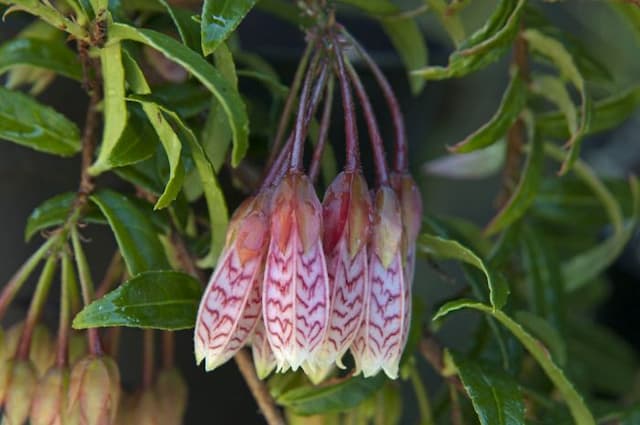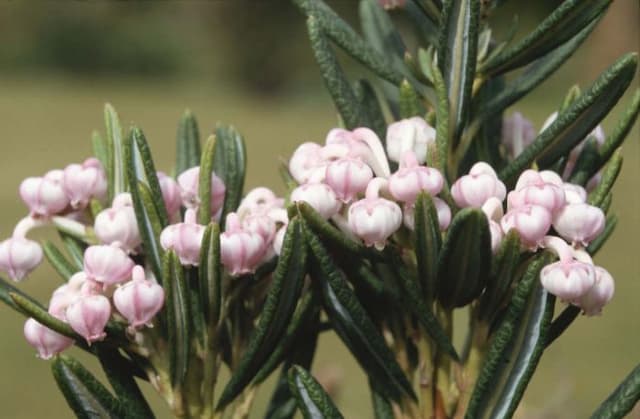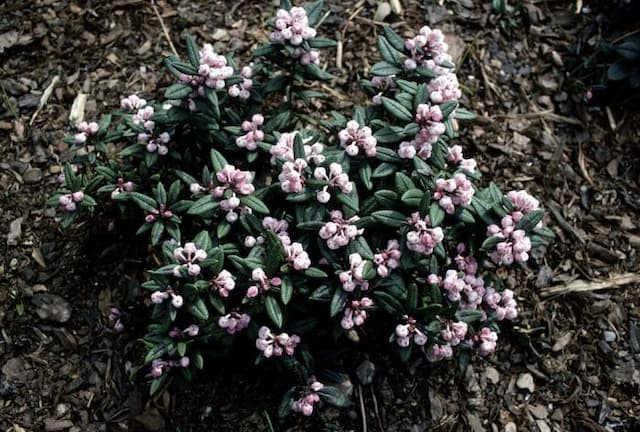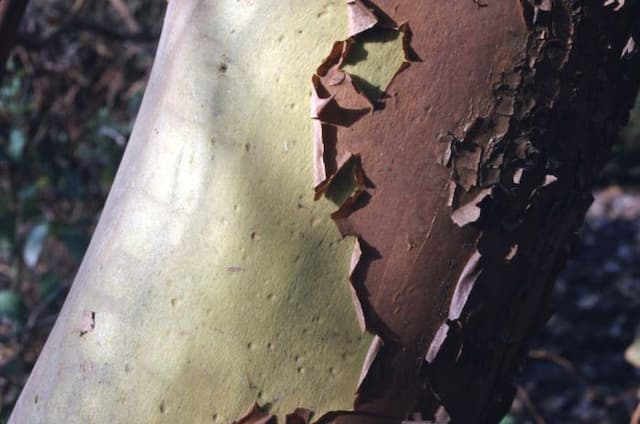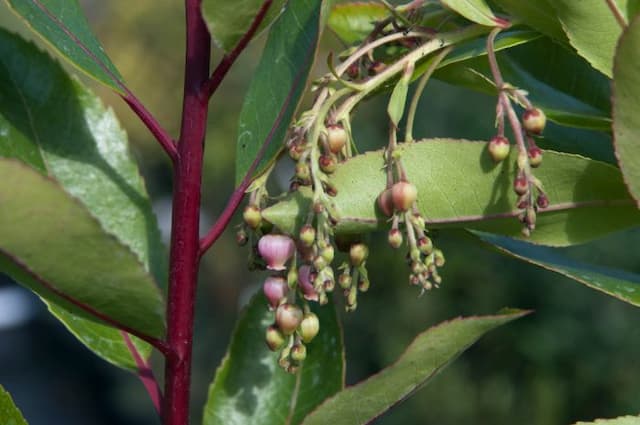Prickly Heath Gaultheria mucronata

ABOUT
Gaultheria mucronata, commonly known as prickly heath, sports small, leathery, evergreen leaves which are usually glossy and bear a sharp tip, giving them a prickly feel to the touch. The leaves create a dense, mat-like coverage over the branches. Depending on the variety, the foliage can present a range of colors from bright green to reddish or purplish hues during different seasons. Throughout spring and summer, prickly heath is adorned with delicate bell-shaped flowers. These flowers can vary in color, typically blooming in shades of white, pink, or rose. After the flowering period, the plant produces colorful, berry-like fruits. The berries are particularly eye-catching and can range from white to pink or even deep red, persisting into winter and providing a striking contrast against the foliage. The overall structure of prickly heath is rounded, forming a bushy appearance. The stems are slender and may take on a reddish tint. This plant exudes a subtle charm, with its compact form and year-round visual interest making it a favorite for gardens seeking continuous color and texture.
About this plant
 Names
NamesFamily
Ericaceae.
Synonyms
Prickly Heath, Spiky Heath.
Common names
Pernettya mucronata, Gaultheria mucronata var. mucronata, Pernettya mucronata var. mucronata, Gaultheria mucronata f. mucronata, Gaultheria mucronata var. longifolia, Pernettya mucronata f. mucronata, Pernettya mucronata var. longifolia.
 Toxicity
ToxicityTo humans
Prickly heath is generally considered non-toxic to humans. However, as with many plants, individual sensitivities can occur, and it's always advisable to avoid ingesting plant parts that are not known to be edible. There are no well-documented cases of poisoning from consuming prickly heath, and it is not typically associated with serious health concerns to humans upon ingestion.
To pets
Prickly heath is not specifically listed as toxic to pets, such as cats and dogs. However, caution should be exercised as pets may have different sensitivities to plants than humans. If a pet ingests a significant amount of prickly heath and exhibits any unusual symptoms, it would be prudent to contact a veterinarian. Common signs of plant poisoning can include vomiting, diarrhea, drooling, or lethargy. Nonetheless, prickly heath is not commonly associated with severe toxicity in pets.
 Characteristics
CharacteristicsLife cycle
Perennials
Foliage type
Evergreen
Color of leaves
Green
Flower color
Pink
Height
3 feet (0.91 meters)
Spread
3 feet (0.91 meters)
Plant type
Shrub
Hardiness zones
7
Native area
Chile
Benefits
 General Benefits
General Benefits- Ornamental value: Gaultheria mucronata, commonly known as prickly heath, is often used in gardens for its attractive foliage and bright, colorful berries, which add visual interest throughout multiple seasons.
- Wildlife attraction: Prickly heath can attract various wildlife, such as birds that feed on its berries, thus contributing to biodiversity in the garden.
- Low maintenance: Prickly heath is considered a low-maintenance plant, which can be ideal for gardeners who prefer plants that do not require much care or frequent attention.
- Cold Tolerance: This plant is quite hardy and can tolerate low temperatures, making it suitable for cooler climates or as a winter-interest plant.
- Ground cover: Due to its dense growth habit, prickly heath can be used as ground cover, helping to suppress weeds and reduce soil erosion in garden beds.
 Medical Properties
Medical Properties- Analgesic: Gaultheria mucronata may have been traditionally used for its pain-relieving properties.
- Anti-inflammatory: The plant could have applications for reducing inflammation in traditional remedies.
- Antirheumatic: It may have been used in the past to treat rheumatic pain and conditions.
 Air-purifying Qualities
Air-purifying QualitiesThis plant is not specifically known for air purifying qualities.
 Other Uses
Other Uses- Gaultheria mucronata, commonly known as prickly heath, is often used in floral arrangements for its attractive berries and dense foliage.
- In landscaping, prickly heath serves as an excellent groundcover due to its spreading nature and evergreen leaves.
- Prickly heath's berries can be used as a natural dye source for fabrics, giving a muted, natural color.
- Gardeners might use prickly heath for controlling soil erosion on sloped areas due to its root system.
- In miniature gardens or fairy gardens, prickly heath can be pruned to resemble miniature trees or shrubs.
- The dense growth habit of prickly heath makes it a good habitat plant for small garden wildlife, like insects and birds.
- Some enthusiasts of bonsai may utilize prickly heath as a subject due to its small leaves and potential for intricate branch structure.
- During the autumn and winter, prickly heath bears attractive berries that can be harvested and used for making homemade wreaths and other holiday decorations.
- In colder regions, prickly heath is planted as a winter-interest plant because it retains its leaves and often its berries during mild winters.
- Prickly heath can act as a living mulch, its foliage helping to retain soil moisture and suppress weed growth beneath taller plants.
Interesting Facts
 Feng Shui
Feng ShuiThe plant Gaultheria mucronata, commonly known as prickly heath, is not used in Feng Shui practice.
 Zodiac Sign Compitability
Zodiac Sign CompitabilityPrickly heath is not used in astrology practice.
 Plant Symbolism
Plant Symbolism- Protection: Gaultheria mucronata, commonly known as prickly heath, often symbolizes protection due to its prickly appearance, which can deter animals and humans from traversing closely or handling it carelessly.
- Resilience: Its ability to thrive in various conditions and withstand cold climates makes prickly heath a symbol of resilience and endurance in the face of adversity.
- Purity: The bright white, pink, or red berries of prickly heath, along with its evergreen nature, are often associated with purity and the constant renewal of life.
 Water
WaterPrickly Heath, or Gaultheria mucronata, prefers consistently moist soil without being waterlogged. Water the plant thoroughly when the top inch of soil feels dry to the touch, approximately every 7 to 10 days, using about 1-2 gallons of water each time depending on plant size and environmental conditions. Avoid allowing the soil to completely dry out, which can stress the plant. During the winter months, reduce watering frequency as the plant's water requirements decrease. Ensure proper drainage to prevent root rot.
 Light
LightPrickly Heath requires partial shade to full sun conditions for optimal growth. The best spot for this plant is an area that receives filtered sunlight or a few hours of direct morning sunlight with protection from the harsh afternoon sun. Too much direct sunlight can cause the leaves to scorch, while too little light can result in sparse, leggy growth.
 Temperature
TemperaturePrickly Heath thrives in cooler temperatures, ideally between 60 to 75 degrees Fahrenheit, but it can survive in temperatures as low as 20 degrees and as high as 80 degrees Fahrenheit. The plant is hardy and can tolerate frost, making it suitable for outdoor cultivation in many climates. Avoid exposure to extreme heat, which can be detrimental.
 Pruning
PruningPrickly Heath benefits from light pruning to maintain its shape and encourage bushy growth. Prune in late winter or early spring before new growth begins. Remove any dead or damaged branches and trim back overgrown areas to promote air circulation and healthy new stems. Pruning is typically done annually or as needed to control the plant's size.
 Cleaning
CleaningAs needed
 Soil
SoilThe best soil mix for prickle-leaf (Gaultheria mucronata) is acidic, well-draining soil with a pH of 4.5-6. A mix of peat, sand, and pine bark is ideal for maintaining the right conditions.
 Repotting
RepottingPrickle-leaf (Gaultheria mucronata) should be repotted every 2 to 3 years to refresh the soil and accommodate root growth. It's best to do this in the spring.
 Humidity & Misting
Humidity & MistingPrickle-leaf (Gaultheria mucronata) thrives in moderate to high humidity levels, ideally between 50% and 60%. Avoid placing in dry environments.
 Suitable locations
Suitable locationsIndoor
Place prickle-leaf in acidic soil, bright indirect light, and maintain high humidity.
Outdoor
Plant prickle-leaf in moist, acidic soil, partial shade, and shelter from wind.
Hardiness zone
7-9 USDA
 Life cycle
Life cycleGaultheria mucronata, commonly known as prickly heath, begins its life cycle when its seeds germinate, typically requiring a cold period to break dormancy. After germination, the seedling develops a root system and a rosette of leaves in its juvenile phase. As the plant matures, it enters a vegetative stage, growing upright stems and more leaves, developing into a shrub. During the reproductive stage, usually in spring to early summer, the plant produces small, bell-shaped flowers that are pollinated by insects. Following pollination, the flowers develop into colorful, berry-like fruits which contain the seeds for the next generation. The plant may enter a period of dormancy in winter, particularly in colder climates, before resuming growth in the spring.
 Propogation
PropogationPropogation time
Spring-early summer
Propogation: Gaultheria mucronata, commonly known as prickly heath, is typically propagated using seeds or by semi-hardwood cuttings. The most popular method of propagation for prickly heath is through semi-hardwood cuttings. These cuttings are best taken in late summer, as this is when the current season's growth has started to mature but is not fully hardened. Cuttings should be about 4 to 6 inches (10 to 15 centimeters) long and include several leaves. They can be dipped in rooting hormone powder to increase the chances of successful root development and then placed in a well-draining soil mix. The soil should be kept moist but not waterlogged, and the cuttings should be placed in a bright, indirect light situation until roots have established, which can take several weeks. Once rooted, the young plants can be transplanted into individual pots or directly into the garden.
